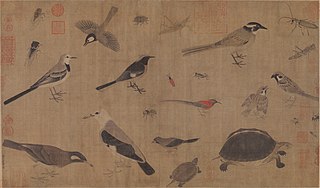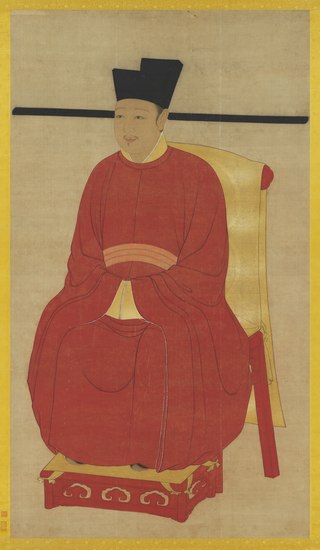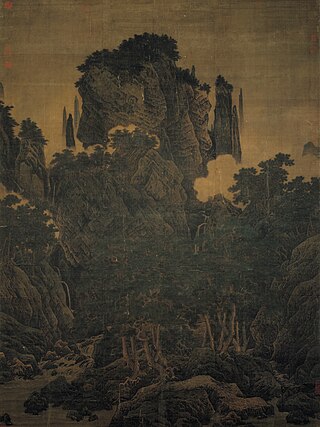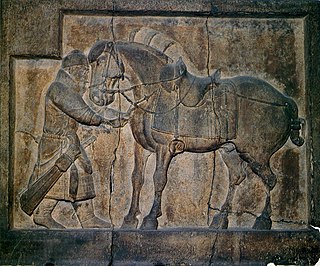This article relies largely or entirely on a single source .(March 2019) |
| |||
|---|---|---|---|
| +... |
| 1070s .1080s in art. 1090s |
| Art timeline |
The decade of the 1080s in art involved some significant events.
This article relies largely or entirely on a single source .(March 2019) |
| |||
|---|---|---|---|
| +... |
| 1070s .1080s in art. 1090s |
| Art timeline |
The decade of the 1080s in art involved some significant events.


Chinese art is visual art that originated in or is practiced in China, Greater China or by Chinese artists. Art created by Chinese residing outside of China can also be considered a part of Chinese art when it is based on or draws on Chinese culture, heritage, and history. Early "Stone Age art" dates back to 10,000 BC, mostly consisting of simple pottery and sculptures. After that period, Chinese art, like Chinese history, was typically classified by the succession of ruling dynasties of Chinese emperors, most of which lasted several hundred years. The Palace Museum in Beijing and the National Palace Museum in Taipei contains extensive collections of Chinese art.

Ink wash painting ; is a type of Chinese ink brush painting which uses washes of black ink, such as that used in East Asian calligraphy, in different concentrations. It emerged during the Tang dynasty of China (618–907), and overturned earlier, more realistic techniques. It is typically monochrome, using only shades of black, with a great emphasis on virtuoso brushwork and conveying the perceived "spirit" or "essence" of a subject over direct imitation. Ink wash painting flourished from the Song dynasty in China (960–1279) onwards, as well as in Japan after it was introduced by Zen Buddhist monks in the 14th century. Some Western scholars divide Chinese painting into three periods: times of representation, times of expression, and historical Oriental art. Chinese scholars have their own views which may be different; they believe that contemporary Chinese ink wash paintings are the pluralistic continuation of multiple historical traditions.

Chinese painting is one of the oldest continuous artistic traditions in the world. Painting in the traditional style is known today in Chinese as guó huà, meaning "national painting" or "native painting", as opposed to Western styles of art which became popular in China in the 20th century. It is also called danqing. Traditional painting involves essentially the same techniques as calligraphy and is done with a brush dipped in black ink or coloured pigments; oils are not used. As with calligraphy, the most popular materials on which paintings are made are paper and silk. The finished work can be mounted on scrolls, such as hanging scrolls or handscrolls. Traditional painting can also be done on album sheets, walls, lacquerware, folding screens, and other media.

Zhao is a Chinese-language surname. The name is first in the Hundred Family Surnames – the traditional list of all Chinese surnames – because it was the emperor's surname of the Song dynasty (960–1279) when the list was compiled. The first line of the poem is 趙錢孫李.

Emperor Huizong of Song, personal name Zhao Ji, was the eighth emperor of the Song dynasty of China and the penultimate emperor of the Northern Song dynasty. He was also a very well-known painter, poet and calligrapher. Born as the 11th son of Emperor Shenzong, he ascended the throne in 1100 upon the death of his elder brother and predecessor, Emperor Zhezong, because Emperor Zhezong's only son died prematurely. He lived in luxury, sophistication and art in the first half of his life. In 1126, when the Jurchen-led Jin dynasty invaded the Song dynasty during the Jin–Song Wars, Emperor Huizong abdicated and passed on his throne to his eldest son, Zhao Huan while Huizong assumed the honorary title of Taishang Huang. The following year, the Song capital, Bianjing, was conquered by Jin forces in an event historically known as the Jingkang Incident. Emperor Huizong and Emperor Qinzong and the rest of their family were taken captive by the Jurchens and brought back to the Jin capital, Huining Prefecture in 1128. The Emperor Taizong of Jin, gave the former Emperor Huizong a title, Duke Hunde, to humiliate him. After Zhao Gou, the only surviving son of Huizong to avoid capture by the Jin, declared himself as the dynasty's tenth emperor as Emperor Gaozong, the Jurchens used Huizong, Qinzong, and other imperial family members to put pressure on Gaozong and his court to surrender. Emperor Huizong died in Wuguocheng after spending about nine years in captivity. He, along with his successors, were blamed for the Song dynasty's decline.

Zhao Mengfu, was a Chinese calligrapher, painter, and scholar during the Yuan dynasty. He was a descendant of the Song dynasty's imperial family through Emperor Xiaozong's brother Zhao Bogui who married a lady surnamed Song who was the granddaughter of Emperor Huizong. Zhao Bogui was a descendant of Emperor Taizu, through his son Zhao Defang.

Emperor Ningzong of Song, personal name Zhao Kuo, was the 13th emperor of the Song dynasty of China and the fourth emperor of the Southern Song dynasty. He reigned from 1194 until his death in 1224.

Li Tang was a Chinese landscape painter who practised at Kaifeng and Hangzhou during both the Northern Song and Southern Song dynasty. He forms a link between earlier painters such as Guo Xi, Fan Kuan and Li Cheng and later artists such as Xia Gui and Ma Yuan. He perfected the technique of "axe-cut" brush-strokes and his style of painting became for what is regarded as the academy-style landscape of the Southern Song.

Huang Tingjian was a Chinese calligrapher, painter, and poet of the Song dynasty. He is predominantly known as a calligrapher, and is also admired for his painting and poetry. He was one of the Four Masters of the Song Dynasty, and was a younger friend of Su Shi and influenced by his and his friends' practice of literati painting, calligraphy, and poetry; regarded as the founder of the Jiangxi school of poetry.

Yan Liben, formally Baron Wenzhen of Boling (博陵文貞男), was a Chinese architect, painter, and politician during the early Tang dynasty. His most famous work, possibly the only genuine survival, is the Thirteen Emperors Scroll. He also painted the Portraits at Lingyan Pavilion, under Emperor Taizong of Tang, commissioned in 643 to commemorate 24 of the greatest contributors to Emperor Taizong's reign, as well as 18 portraits commemorating the 18 great scholars who served Emperor Taizong when he was the Prince of Qin. Yan's paintings included painted portraits of various Chinese emperors from the Han dynasty up until the Sui dynasty (581–618) period. His works were highly regarded by the Tang writers Zhu Jingxuan and Zhang Yanyuan, who noted his paintings were "works among the glories of all times".

Shen Zhou, courtesy names Qinan (启南) and Shitian (石田), was a Chinese painter in the Ming dynasty. He lived during the post-transition period of the Yuan conquest of the Ming. His family worked closely with the government and maintained its wealthy status. Shen later retired and lived a reclusive life, spending most of his time painting and taking care of his widowed mother.

Along the River During the Qingming Festival is a handscroll painting by the Song dynasty painter Zhang Zeduan (1085–1145) and copied or recreated many times in the following centuries. It captures the daily life of people and the landscape of the capital, Bianjing during the Northern Song. The theme is often said to be the spirit and worldly commotion at the Qingming Festival, rather than the holiday's ceremonial aspects, such as tomb sweeping and prayers. Read right to left, as a viewer would unroll it, successive scenes reveal the lifestyle of all levels of the society from rich to poor as well as economic activities in both rural areas and the city, and offer glimpses of clothing and architecture. The painting is considered the most renowned work among all Chinese paintings, and it has been called "China's Mona Lisa."

Ma Yuan was a Chinese painter of the Song dynasty. His works, together with that of Xia Gui, formed the basis of the so-called Ma-Xia (馬夏) school of painting, and are considered among the finest from the period. His works has inspired both Chinese artists of the Zhe school, as well as the early Japanese painters Shūbun and Sesshū.

Cui Bai was a prominent Chinese painter of the Northern Song Dynasty (960–1279). A native of Anhui Province, Cui was best known for paintings of animals and plants. At some point during his life, he traveled to the capital of Kaifeng to seek employment as a court artist, and was accepted by Emperor Shenzong of Song, who admired his works. He became a renowned artist of Shenzong's court, but gained an awkward reputation for his often eccentric behavior.
The decade of the 1130s in art involved some significant events.
The decade of the 1100s in art involved some significant events.
Gong Kai was a Chinese painter, poet, and politician during the last years of the Song dynasty. The latter part of the Song dynasty, in which Gong Kai lived, is known as the Southern Song dynasty (1127–1279). After the fall of the Song dynasty to the Yuan dynasty, he became what was known as a scholar-amateur painter. The artists of the Song were mostly influenced by momentary and sporadic pleasures and beauty. However, there is no evidence that Gong Kai painted during this period. Instead, most paintings attributed to Gong Kai are from Yuan dynasty (1271–1368).

Wang Ximeng was a Chinese painter during the Northern Song period, in the early twelfth century. A prodigy, Wang was a student at the imperial court's school of paintings, where he was noticed by Emperor Huizong of Song, who saw Wang's talent and personally taught him. In 1113, at the age of 18, he created his only surviving work, a long blue-green scroll called A Thousand Li of Rivers and Mountains. He died at the age of 23.

The House of Zhao was the imperial clan of the Song dynasty (960–1279) of China.

Wang Shen, courtesy name Jinqing, was a Chinese calligrapher, painter, poet, and politician of the Song dynasty. He is best known for his surviving paintings, poetry, and calligraphy, and for his relationships with prominent statesmen and early amateur literati artists such as Su Shi, Huang Tingjian and Mi Fu.